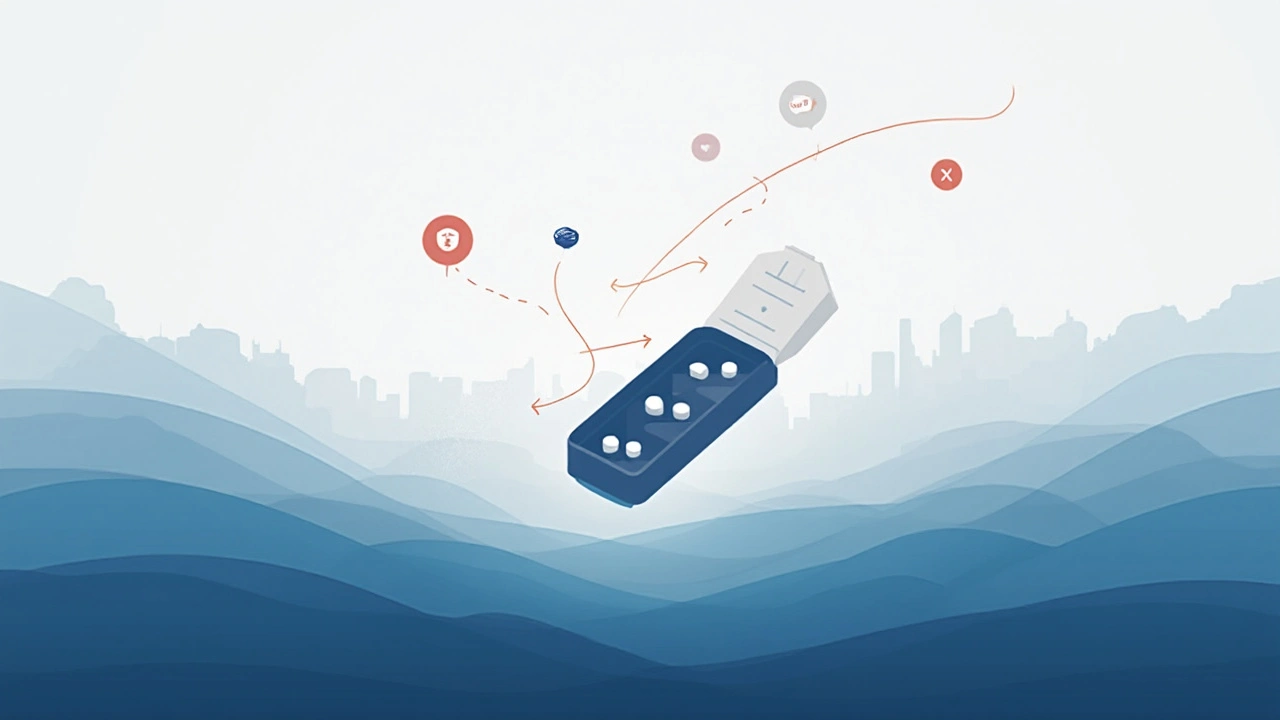Picture this: someone starts an antidepressant for the first time, thinking it will finally help with the darkness hovering overhead. But a few weeks in, things shift. The world turns way too bright, sleep vanishes, and their energy turns wild, maybe even reckless. If that person has bipolar disorder, this isn't the fix they hoped for—it's the reality when some antidepressants, like nortriptyline, get thrown into the mix without careful planning. Let’s pull back the curtain on nortriptyline and bipolar disorder—because sometimes, fixing the lows can tip the scales into dangerous highs.
How Nortriptyline Works and Where It Fits in Bipolar Disorder
Nortriptyline just sounds scientific, right? It’s actually been around for decades, one of those tried-and-true antidepressants from the tricyclic family. This drug works by nudging certain brain chemicals—mainly norepinephrine and, to a lesser extent, serotonin—to stick around longer in your brain. That might make you feel more alert, less weighed down by depression, and sometimes give the edge back to your day.
Now, in classic depression (the garden variety, without mood swings), this can be a game-changer. But bipolar disorder isn’t your average depression. The mood swings are extreme—deep valleys of depression, sky-high peaks of mania. Here’s the tricky part: giving someone with bipolar disorder a powerful antidepressant like nortriptyline can sometimes nudge them right into a manic episode or a fast, back-and-forth cycling that’s hard to control.
Nortriptyline is rarely the first tool a psychiatrist will grab for someone with bipolar disorder. Usually, the treatment starts with a mood stabilizer—think lithium, valproate, or lamotrigine. Those are the real foundation, keeping wild mood swings in check. Only when depression lingers and refuses to budge, despite stable mood, will a doctor carefully consider adding an antidepressant like nortriptyline—and never without a mood stabilizer alongside. The risk is too high for triggering mania otherwise.
The numbers tell a clear story. A 2023 review from the Journal of Clinical Psychiatry showed that about 15-40% of people with bipolar disorder may tip into mania or mixed episodes if treated with a tricyclic antidepressant without a mood stabilizer. That’s not a roll of the dice anyone wants.
If you’re curious about how nortriptyline measures up to other antidepressants, it’s considered more effective for “melancholic” depression—that’s a deep, often physical, sadness with loss of pleasure, early morning awakening, and slow movement or thinking. But again, there’s a cost: the same drug is more likely than others (like SSRIs) to trigger mania in people with bipolar disorder.
Here’s a table that shows how often tricyclic antidepressants like nortriptyline can shift moods in bipolar patients, compared to other antidepressant types:
| Antidepressant Type | Chance of Triggering Mania in Bipolar Disorder |
|---|---|
| Tricyclics (Nortriptyline, Amitriptyline) | 15-40% |
| SSRIs (Fluoxetine, Sertraline) | 5-15% |
| SNRIs (Venlafaxine, Duloxetine) | 10-20% |
| Bupropion | 3-10% |
So, if you or someone you care about has bipolar disorder and a doctor suggests nortriptyline, stop and have a real conversation. Ask if there’s a mood stabilizer on board, what warning signs to watch for, and how the plan will be adjusted if moods get out of control.

Risks, Side Effects, and the Importance of Warning Signs
With nortriptyline, side effects come with the territory, and the stakes are higher for people with bipolar disorder. Even in folks without mood issues, nortriptyline can cause dry mouth, constipation, blurred vision, urinary problems, sleepiness, weight gain, and heart rhythm changes. Now add bipolar disorder to the picture. There’s not just the risk of side effects—there’s a real danger of mood destabilization.
When nortriptyline triggers mania in bipolar disorder, the warning signs can sneak up fast, or hit like a freight train:
- Sudden bursts of energy, talking all the time
- No need for sleep but not feeling tired
- Grand, unrealistic ideas or risky plans
- Spending sprees, unsafe choices, or reckless behavior
- Getting irritable or agitated out of the blue
Don’t brush off those changes. Mania isn’t just feeling great—it can wreck relationships, jobs, and even get the person in trouble with the law. Mixed episodes, where depression and mania crash together, are even harder to deal with—restless, agitated, and deeply hopeless, all at once.
Here’s the catch: not everyone reacts the same way to nortriptyline. Genetics, age, other health problems—these all matter. There’s actually a blood test for nortriptyline levels (called a therapeutic drug monitoring test) because too much in the bloodstream can crank up the risk of side effects or even toxicity. Oddly, older adults need lower doses because their bodies process the drug much slower.
Let’s look at a few practical ways to spot and stop trouble before it escalates:
- If starting nortriptyline, track moods every day for the first weeks. A simple journal or app can pick up subtle changes before things spiral out of control.
- Involve someone close—family or friends can often spot warning signs of mania before the person does.
- Never skip mood stabilizers. Adding nortriptyline without one is like tossing a lit match at dry leaves.
- If new symptoms—rapid speech, insomnia, wild plans—pop up after starting, talk to your doctor right away. Don’t wait for things to settle down.
- Adjustments to the dose need caution. Most doctors start low and go slow, usually increasing every 1-2 weeks, especially for people with bipolar disorder.
It’s easy to forget just how much heart issues matter with nortriptyline. The drug can alter heart rhythms, potentially causing dangerous arrhythmias, especially in those with previous heart problems or who take other medications that affect the heart. This is why doctors often order an ECG (electrocardiogram) before starting nortriptyline, especially for anyone over 40 or with a heart history.
Take it from real-world experience: no one likes the feeling of wondering if a pill is about to make them lose control. But when nortriptyline is handled carefully, used alongside a good mood stabilizer, and tracked closely, the risks are a lot smaller—and sometimes, the deep depressive spells can finally lift.

When Nortriptyline Makes Sense and How to Use it Safely
Why roll the dice on nortriptyline if there’s so much risk? Sometimes, it’s the only thing that works when nothing else has managed to break through stubborn bipolar depression. Not every medication is a perfect fit, and brains are tricky. For some people, nortriptyline is the lifeline after other options—SSRIs, SNRIs, or psychotherapy—fail again and again.
Doctors might choose nortriptyline for bipolar patients in a few scenarios:
- The depressive episode is severe, classic melancholic type, and hasn’t budged with other antidepressants.
- The patient tolerates tricyclics well and has a reliable support system to monitor for warning signs.
- There’s a mood stabilizer on board, and the patient’s history suggests lower risk for rapid cycling or mania.
Here’s how to stack the odds in your favor if you and your doctor decide to try nortriptyline for bipolar disorder:
- Pair it with a proven mood stabilizer. This isn’t negotiable. No mood stabilizer, no nortriptyline for bipolar—it’s that simple. The stabilizer is your guardrail against mania.
- Check your heart health. Get that baseline ECG if you’re over 40 or have any history of heart disease.
- Start with the lowest dose and increase very slowly. Most folks start at 10-25 mg at night. There’s no rush—more time lets any brewing mania show up early.
- Blood level checks matter. Nortriptyline can pile up silently, so doctors may order a blood test after a few weeks to make sure you’re in a safe zone (usually 50–150 ng/mL).
- Steady routines help. Take your medication at the same time each day, don’t skip doses, and keep your appointments. Small habits plug up big cracks where trouble sneaks in.
- Don’t go it alone. Enlist a partner, friend, or family member to help track mood, sleep, and energy. Someone else’s perspective can catch changes that you miss.
- Never stop or change doses without your doctor’s okay. Withdrawal from nortriptyline can feel rough—dizziness, sleep problems, flu-like symptoms, and a risk of new depression or mania.
- If side effects show up—anything from a racing heart to unbearable dry mouth—keep your doctor in the loop. It’s often possible to adjust timing or dose to ease the burden.
- Remember the long-haul plan. Nortriptyline is rarely forever. Most psychiatrists aim to taper off antidepressants in bipolar disorder after a few months if mood is steady.
- Stay honest about how you’re really doing. Your story matters just as much as blood tests and scores on a depression scale.
Can people live full, stable lives with bipolar disorder, even if they’ve needed nortriptyline at some point? Absolutely. But it’s never just the pill. It’s planning, partnership with a great mental health team, honest self-monitoring, and the wisdom to know when something doesn’t feel right. If you ever feel a mood shift coming—too much energy, too little hope—don’t wait. The sooner you get help, the better the outcome.
Nortriptyline isn’t the villain or the hero. It’s just another tool, and with the right guardrails, it can be a useful part of the toolkit. But for folks with bipolar disorder, that ‘right way’ always means respecting the danger it poses, tracking every shift, and never going it alone. Keep asking the questions. Be the expert on your own life. And lean on your team—they want what’s best for you, not just what’s easy.


Dominic Dale
July 18, 2025 AT 03:05This article really scratches the surface but also touches on some critical points that most people overlook when it comes to nortriptyline in bipolar disorder treatment. What I find alarming, and I mean genuinely alarming, is how often such medications are pushed without a full understanding of the nuanced risks. We all know how pharmaceutical companies work, right? They gloss over side effects because, well, money.
Nortriptyline isn't your average antidepressant; it has a complex interaction with neurotransmitters that can sometimes trigger manic episodes, a risk that is often downplayed. I'm curious if the article delves into how patients manage these side effects practically? Because the real challenge isn't just taking the medication but balancing the mood swings it might induce.
Furthermore, I've heard whispers about the lack of long-term studies on this use specifically for bipolar disorder. Is anyone else skeptical about the standard protocols here? We need more transparency and patient-centered approaches rather than standardized mass treatment plans. Thoughts?
Bridget Dunning
July 18, 2025 AT 03:58I appreciate the article's intent to demystify nortriptyline's role in bipolar disorder therapy, but I would caution readers to not oversimplify this pharmacological interaction. Nortriptyline, as a tricyclic antidepressant, engages with the monoaminergic systems in quite a complex manner, which can both benefit and potentially destabilize patients depending on their individual neurochemical milieu.
The article commendably avoids excessive jargon but retains a clear exposition that patients and caregivers can digest. Still, I must emphasize that any administration of such drugs should be under vigilant psychiatric supervision with tailored dosage adjustments. Bipolar disorder management is not merely symptomatic treatment but a delicate orchestration requiring nuanced understanding of each patient's unique pathophysiology.
Jessica Hakizimana
July 18, 2025 AT 05:08It's so heartening to see an article that speaks plainly yet responsibly about nortriptyline and bipolar disorder. Many people feel overwhelmed when trying to understand their treatment options. This kind of clear, honest guidance can empower patients and caregivers alike to ask the right questions and advocate for safer care.
The inclusion of real stories and evidence-based advice sets a hopeful tone because managing bipolar disorder is undeniably challenging—but not insurmountable. I do wonder, though, how accessible this information is to those with limited healthcare literacy? Sometimes the best advice still remains out of reach for the most vulnerable.
Ultimately, awareness and education are stepping stones to mental wellness—articles like this are invaluable in that journey.
Patrick Price
July 18, 2025 AT 06:21hey everyone i just read the post and i gotta say i wonder if the authors really covered all the risks cause my cousin took nortriptyline and well... things got kinda complicated real fast :/ maybe its the bipolar or maybe the med but those mood swings got worse? did anyone else experience that? also the article kinda glossed over the side effects in my opinion id love more deets honestly like how to cope when side effects hit hard lol
also big question is how often should u change doses or when do docs decide to switch meds? havent found clear answers anywhere tbh. anyone got good advice or personal stories to share? im all ears cause navigating this stuff blind is scary man
Matthew Holmes
July 18, 2025 AT 07:33it’s wild how things like nortriptyline get recommended and yet you gotta wonder what they’re not telling us about long-term effects especially in bipolar disorder patients. this article hints at the risks but doesn’t quite expose what could be the darker sides, you know?
are we really fully informed or just being pacified with statistics and diluted stories? the medical establishment sometimes seems to have a shiny curtain hiding the real truth. i think we should push for more patient testimonials and independent research rather than rely solely on clinical trials sponsored by pharma giants.
the balance between benefits and risks might be tipping, but they don’t want us to see it yet.
Shweta Dandekar
July 18, 2025 AT 09:26First and foremost, it is of utmost importance to acknowledge that bipolar disorder management necessitates rigorous and scrupulous medical oversight. Nortriptyline is not a panacea and ought not to be perceived as such!!! The dangers of self-medication and the tendency to overlook the profound implications of side effects cannot be overstated!!!
This article, while well-intentioned, must be complemented by stern adherence to psychiatric consultation and therapeutic supervision. To neglect these is not merely reckless, but potentially catastrophic!!! The dissemination of knowledge must be coupled with responsibility and vigilance!!!
Gary Smith
July 18, 2025 AT 10:41Look, I don’t trust half of these meds pushed on people these days. Nortriptyline included. America’s pharma landscape is a circus, with greedy corporations running the show! We see it happening every day, pushing risky drugs without full disclosure of consequences, especially for something as serious as bipolar disorder.
The article’s probably fine as a starting point, but they always underestimate the danger of side effects, which are way worse than they admit. I want to hear from real people who took it, not from sanitized reviews made for corporate interests. Is anyone willing to share their story beyond the clinical gloss?
We all deserve truth, not just polished propaganda.
Sarah DeMaranville
July 18, 2025 AT 12:13The entire premise of the article seems to hinge on a problematic assumption: that nortriptyline is a viable and sensible choice for bipolar disorder management. I find this notion quite dubious and perhaps emblematic of a broader pharmaceutical complicity in the stylistic perpetuation of questionable medical interventions.
One should remain tirelessly skeptical of such narratives, especially when they purport to be clear and practical but ultimately serve to normalize a medication with a fragile evidence base in this area. The discourse ought to be more critical rather than blindly accepting these narratives at face value.
christopher werner
July 18, 2025 AT 23:20Appreciate the thoughtful discussion around nortriptyline's utility and risks. I agree that any medication, especially in bipolar disorder, requires careful patient-doctor collaboration. It's crucial that patients voice concerns about side effects and treatment experiences without hesitation.
Respectfully, each patient's response to nortriptyline will differ, and treatment plans should remain flexible. This article can be a helpful introduction, but nothing replaces personalized medical advice and ongoing monitoring from competent healthcare providers.
Has anyone here had success with alternative medications or supplements adjunct to treatment?
peter derks
July 19, 2025 AT 07:40Great read and comprehensive guide. These kinds of patient-oriented write-ups are essential in bridging the gap between clinical knowledge and real-world applications. For many, bipolar disorder treatment can feel daunting, and accessible information about medications like nortriptyline provides some needed clarity.
However, I'd emphasize the importance of ongoing dialogue with healthcare professionals. Medication regimens aren't one-size-fits-all, and flexibility based on patient response is key to sustained success. It would be interesting to discuss more about how patients monitor their mood changes on nortriptyline and what early warning signs prompt a review of therapy.
Edward Leger
July 19, 2025 AT 21:33The conceptual framework surrounding the use of nortriptyline in bipolar disorder is indeed a fascinating study in clinical pragmatism tempered with empirical reservation. Philosophically, the delicate balance between symptomatic intervention and etiological understanding becomes paramount. This article modestly approaches such a balance by acknowledging the dual nature of benefits and risks.
Yet, it is perhaps the contemplative patient experience and individualized therapeutic journey that remains the cardinal lesson here. The pharmacodynamics of tricyclic antidepressants intersect complexly with affective pathologies, thereby demanding not merely clinical vigilance but a reflective appraisal of each patient's narrative.